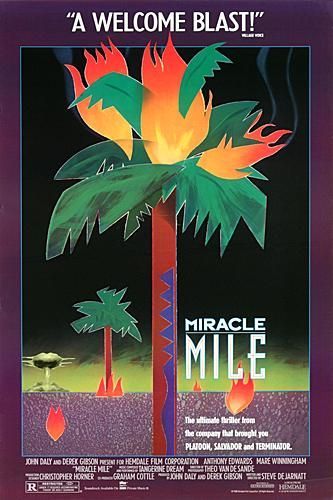 MIRACLE MILE may not actually fall under the category of horror, but it is one of the scariest movies ever made. It’s a cold war thriller like no other, a nightmarish depiction of naked fear and panic in the face of nuclear annihilation.
MIRACLE MILE may not actually fall under the category of horror, but it is one of the scariest movies ever made. It’s a cold war thriller like no other, a nightmarish depiction of naked fear and panic in the face of nuclear annihilation.
The low-budget MIRACLE MILE, released by the late Hemdale Pictures in 1989, was not a success. It was savaged by critics and largely ignored by audiences, yet the film stuck with the few of us who bothered to turn out for it. This includes a major Los Angeles based critic, who admitted at a revival screening that he’d changed his mind about the film after his initial negative review.
In fact, MIRACLE MILE had been attracting attention in screenplay form several years before it was greenlit. The script was given a prominent place in a mid-eighties piece in American Film magazine about the 10 Best Unproduced Screenplays in Hollywood (Bruce Joel Ruben’s then-unproduced script for JACOB’S LADDER was also mentioned). Its writer Steve De Jarnatt ended up directing the film, with Anthony Edwards and Mare Winningham headlining.
Romantic sad sack Harry, a 30-year-old aspiring musician, believes he’s finally found true love with the sunny Julie. The only problem is that on their latest date the power goes out in Harry’s building and he sleeps past 12 PM. That’s the time of the appointed rendezvous outside the coffee shop where Julie works, located on the “Miracle Mile” portion of Wilshire Boulevard. Harry turns up four hours late, by which time Julie has gone home. It seems all is lost…and then Harry hears the ringing of a pay phone.
On impulse he answers it, and hears a desperate voice babbling that “we’re locked in…we’ve shot our load,” and will be “getting it back” in an hour and ten minutes. Apparently the unseen caller works in a missile silo and is referring to nuclear missiles that have just been fired at Russia, who’ve responded in kind. The person thinks he’s calling his dad in Orange County, having dialed the wrong area code. Before Harry can ferret out any more info there is the sound of gunshots and a stern voice telling him to “forget everything you’ve just heard and go back to sleep!”
Harry feels compelled to tell the coffee shop’s early morning patrons of what he’s heard, which leads to a mad dash by many of those patrons to LAX. Harry makes his way to Julie’s place, picks her up and heads for a helicopter rendezvous atop a bank building.
But now he’s faced with a new problem: there’s no one to fly the coptor, and where does one find such a person at 4 AM on the Miracle Mile? It doesn’t help matters that time is running out and panic is spreading among LA’s populace, fuelled by rumors of an impending nuclear Armageddon–started, of course, by Harry himself!
MIRACLE MILE works largely because it’s so unprecedented in style and execution. The opening scenes have an amiable eighties romcom feel, with Anthony Edwards doing a reprise of his likeable nerd act from REVENGE OF THE NERDS and GOTCHA. There’s no indication of an apocalyptic turn of events, which makes the relentlessness of much of the rest of the film, set entirely in real time, all the more shocking.
It’s precisely that aspect, alas, that got the film into trouble with critics and audiences. Back in 1989 movie heroes tended to be pumped-up musclemen of the Stallone-Schwarzenegger variety, while Anthony Edwards is something else entirely: a thoroughly average guy hopelessly unequipped for the bizarre and horrific circumstances he finds himself thrust into.
The prime criticism MIRACLE MILE received was that Edwards’ behavior is illogical. A search for a helicopter pilot in an all-night gym? Ridiculous. Crossing a riot-torn street because there’s a guy on the other side who looks like (but isn’t) the desired pilot? Even more so. But who among us can honestly say they’d behave differently? The film’s illogic is that of a nightmare, punctuated with several impossible-to-forget images: a dying man trying to climb a descending escalator, a corpse’s head obscuring the view through a manhole, a ranting madman watching missiles zip through the sky above him, etc.
Problems? There are a few. The idea of setting the majority of the action on and around the Miracle Mile section of Wilshire Boulevard (most likely for budgetary reasons) feels a mite contrived; we’re supposed to believe the protagonists both live and work in the area, which I had difficulty swallowing. There’s also the issue of the low budget, which doesn’t do Steve De Jarnatt’s ambitions justice, particularly in the cute-rate riot scenes and crummy special effects of the third act.
But MIRACLE MILE works, functioning both as edge-of-the-seat entertainment and alarmingly prescient social commentary.
Vital Statistics
MIRACLE MILE
Hemdale Film Corporation
Director: Steve De Jarnatt
Producers: John Daly, Derek Gibson
Screenplay: Steve De Jarnatt
Cinematography: Theo Van De Sande
Editing: Stephen Semel
Cast: Anthony Edwards, Mare Winningham, John Agar, Lou Hancock, Mykelti Williamson, Kelly Jo Minter, Kurt Fuller, Denise Crosby, Robert DoQui, O-Lan Jones, Claude Earl Jones, Alan Rosenberg
